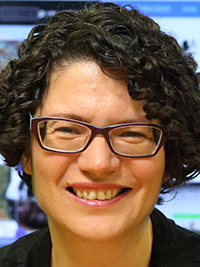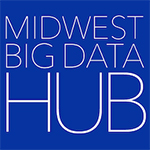By Erica Joo and Qining Wang
We recently spoke with Professor Tanya Berger-Wolf, a pioneer in the area of imageomics who is leading a team to start a new field of imageomics. She is a computational ecologist who is director and co-founder of the nonprofit organization “Wild Me.” Berger-Wolf is also the Director of the Translational Data Analytics Institute (TDAI) and a Professor of Computer Science Engineering, Electrical and Computer Engineering, as well as Evolution, Ecology, and Organismal Biology, at The Ohio State University.

Observation is fundamental to any biological research. The development of optics technology, such as the inventions of the microscope and the telescope, allowed biologists to observe the world at different scales, from animals living in jungles of millions of acres to DNA in animal cells of several micrometers.
However, as Prof. Berger-Wolf pointed out, those inventions only serve to “augment our ability to look” or “look at more things more carefully.” We are still making observations and searching for patterns with our own eyes, from which arises the caveat: We are not so good at finding patterns when things appear to be random, or when patterns are rare, sparse, subtle, or complex. We can’t answer, for example, whether the stripe patterns of mother zebras are similar to their babies’. The patterns appear to be too similar and too random at the same time to our eyes because human brains did not evolve to “take [the stripe patterns] holistically and quantify them in any meaningful way.”
And that’s where imageomics comes in. Imageomics is following genomics, a field where researchers understand the biology of an organism or a species through their genetic information. In a similar vein, imageomics aims to understand nature through biological information extracted from images.
Computers are the perfect information extractors, because they “perceive” the world differently. Computers can quantify images down to pixels and find patterns that humans do not, or cannot, comprehend. Berger-Wolf pointed out that imageomics, as a “whole new field of science,” allows scientists to answer biological questions that weren’t answerable before because it provides scientists with a new way of observing nature.
The complementary vision of computers is especially prominent in the studies of biological traits, according to Berger-Wolf. Biological traits are the interplay between genes and the environment. They can be physical characteristics such as “beak colors, stripe patterns, fin curvatures, the curves of the belly or the back.” They can also be behavioral characteristics such as possums playing dead or pollen feeding in birds. Being able to observe traits “is the foundation of our understanding of how these traits are inherited and the understanding of genetics,” insights into animal behavior, and ecological and evolutionary theories.
In order for biologists to propose new evolutionary hypotheses to explain biological traits, it is crucial to “make these traits computable.” Starting from a project funded by the National Science Foundation, Berger-Wolf founded Wild Me. This nonprofit organization has an ongoing initiative, Wildbook, that collects images containing animals from numerous sources, including camera traps, drones, and even tourists’ social media posts on YouTube, Instagram, and Flickr.
Those source images serve as a starting point for a branch of research in imageomics, which will allow researchers to develop open software and artificial intelligence for the research community. Those tools would allow biologists to discern biological traits that are too similar or too subtle to their eyes, such as animal coat patterns or species that look alike yet are genomically different. Computer vision would allow scientists to find out whether traits are inheritable or shared by multiple species. Based on those new insights, biologists could then conjure new evolutionary hypotheses and start asking even more interesting questions, to which only imageomics can provide the answers.
Berger-Wolf jokes that she has “multiple research personality,” with a passion for bringing her diverse backgrounds together. By helping to found the new Imageomics Institute, her interests were able to converge. Participating in both worlds—natural and technical—allows her to see “the better way” of working and increasing effectiveness.
She commented that starting conversations between fields increases “mutual respect and understanding of each other’s questions and where we can come together.” Berger-Wolf sums up her career by describing her work as “creating tools that expand our ability to look at more things more carefully and even be able to ask questions that people have never been able to ask before.”
Berger-Wolf is currently working on several projects. One looks at animal coat patterns and correlates them with genetics, heritability, and the overall scientific structure of why some traits are inheritable and others are not. By using imageomics, we are able to understand at a deeper level since humans cannot pay attention to every detail. In another project, she is working on species-level traits of butterflies that mimic other species. Computer algorithms can identify what is similar and different in their appearances, down to the small details. Computers can extract complex information and people can start asking different questions using information normally beyond the scope of human perception.
Berger-Wolf’s recent award for the new Imageomics Institute under the NSF Harnessing the Data Revolution program is extending this work and bringing it to a wider audience. The images to be used as sources come from existing research projects, citizen scientists, organizations like iNaturalist, eBird, and Wild Me, as well as the digitization of the natural history museum collections through the iDigBio project.
There are various opportunities for students at any level and researchers from all over the world to participate in the field of imageomics. Berger-Wolf emphasized that the goal is to have people understand what imageomics is and how it’s significant so that it can be accessible to all.
“It’s not just an opportunity to advance science, but also to engage people in science,” she explains. Her team is built up of multiple researchers and students, sharing a goal of building a community around it. More direct community engagement, outreach events, and conferences are great ways for informing people about imageomics and how people can change the way traits are seen.
“We have incredible privilege to do science. To spend time answering scientific questions that are interesting to us while the public is paying us to do so. It’s important to tell the science to the public, communicate why, and what science brings to the world.”
Get Involved
New community-building activities facilitated by the Midwest Big Data Innovation Hub are continuing throughout 2022. Contact the Hub if you’re interested in participating, or are aware of other people or projects we should profile here. The MBDH has a variety of ways to get involved with our community and activities.
The Midwest Big Data Innovation Hub is an NSF-funded partnership of the University of Illinois at Urbana-Champaign, Indiana University, Iowa State University, the University of Michigan, the University of Minnesota, and the University of North Dakota, and is focused on developing collaborations in the 12-state Midwest region. Learn more about the national NSF Big Data Hubs community.
